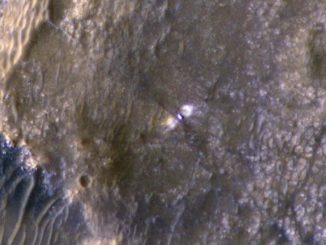
NASA’s Opportunity rover trekking across Mars completed a marathon’s worth of driving Tuesday, extending its record-setting exploration of the red planet as engineers installed a software fix to overcome a problem with the aging robot’s flash memory.
The rover has been operating without the use of its flash memory since December 2014, when ground controllers briefly lost communications with Opportunity as its computer had trouble writing data to a section of on-board non-volatile flash memory.
The flash memory retains data when the solar-powered rover powers down at night, and a separate random access memory system stores data only when the vehicle is powered up. When Opportunity’s long-term data archive became unreliable, ground controllers commanded the rover to send back all the information it collected each day before going to sleep at sunset.
Officials coaxed the rover along without flash memory while engineers wrote new code to beam up to Opportunity to bypass one of the vehicle’s seven banks of memory most responsible for the problems.
Opportunity’s ground team received confirmation March 20 that the memory reformatting completed successfully, structuring the rover’s computer to avoid writing data on Bank 7 of the flash memory archive, NASA said in a press release.
“Opportunity can work productively without use of flash memory, as we have shown for the past three months, but with flash we have more flexibility for operations,” said John Callas, Opportunity’s project manager at NASA’s Jet Propulsion Laboratory in Pasadena, California. “The rover can collect more data than can be returned to Earth on any one day. The flash memory allows data from intensive science activities to be returned over several days.”

There is a limit to how many times the computer can write and erase data in flash memory, and the latest fault is simply a sign of the rover’s age, officials said.
NASA has not guaranteed it can afford to keep Opportunity operating on Mars beyond this year. The agency’s budget request submitted to Congress for 2016 calls for no funding for the Opportunity mission, but NASA officials and lawmakers are optimistic the final spending plan will include money for the rover.
Opportunity landed on Mars on Jan. 24, 2004, and has outlived its 90-day life expectancy more than 45 times.
The six-wheeled robot’s odometer passed 26.219 miles (42.195 kilometers) Tuesday — the equivalent length of a marathon on Earth — after 11 years and two months on Mars.
“This is the first time any human enterprise has exceeded the distance of a marathon on the surface of another world,” Callas said in a press release. “A first time happens only once.”
NASA says Opportunity achieved the marathon feat with a drive of 153 feet (46.5 meters) Tuesday.

Opportunity is currently exploring a region named Marathon Valley on the western rim of Endeavour Crater, a vast impact basin stretching 14 miles across. The rover has surveyed the rim of the crater since it arrived at the destination in 2011.
The long-lived vehicle has recently spotted a bizarre rock outcrop at an overlook of Marathon Valley, which could contain more clues from the red planet’s ancient past, when conditions were favorable for life billions of years ago.
Opportunity broke the record for long-distance driving on another world last year when it passed the mark set by the former Soviet Union’s Lunokhod 2 moon rover.
For comparison, NASA’s Curiosity rover has logged more than 6 miles (10 kilometers) on Mars since it landed in August 2012.
“This mission isn’t about setting distance records, of course; it’s about making scientific discoveries on Mars and inspiring future explorers to achieve even more,” said Steve Squyres, Opportunity’s principal investigator at Cornell University. “Still, running a marathon on Mars feels pretty cool.”
Follow Stephen Clark on Twitter: @StephenClark1.



